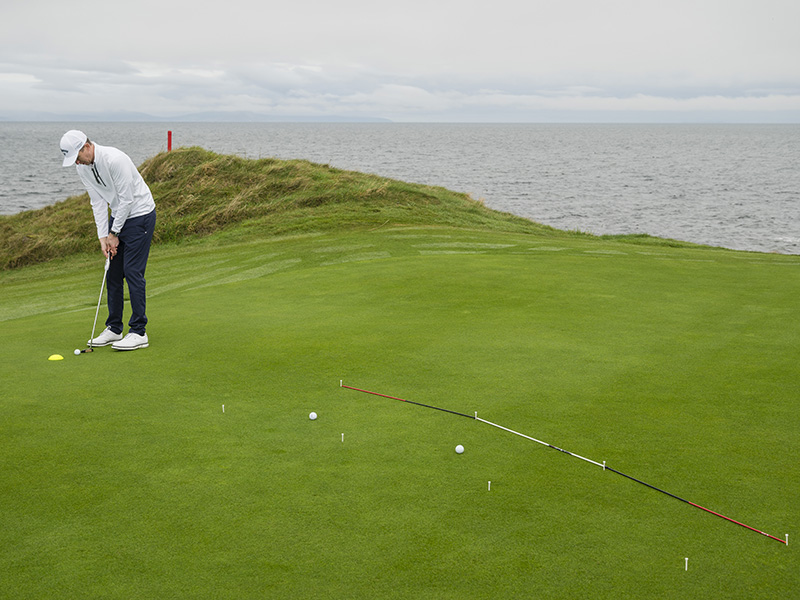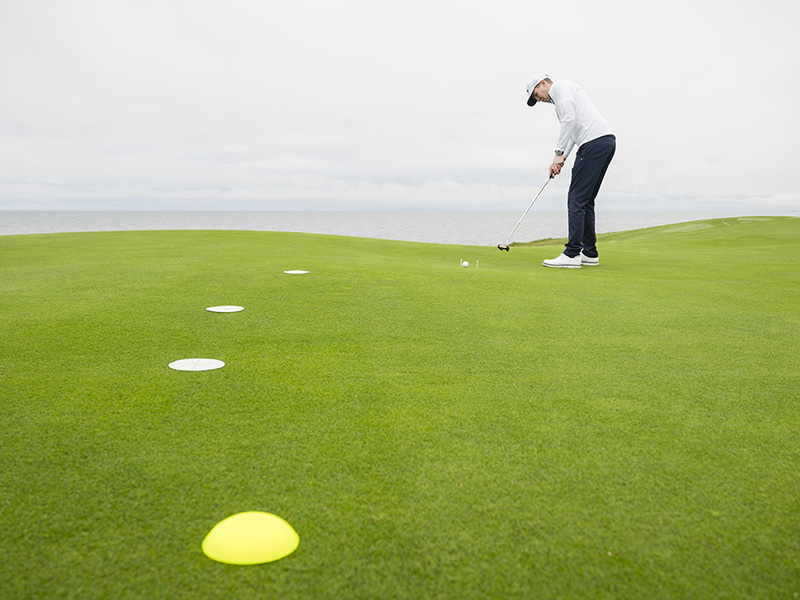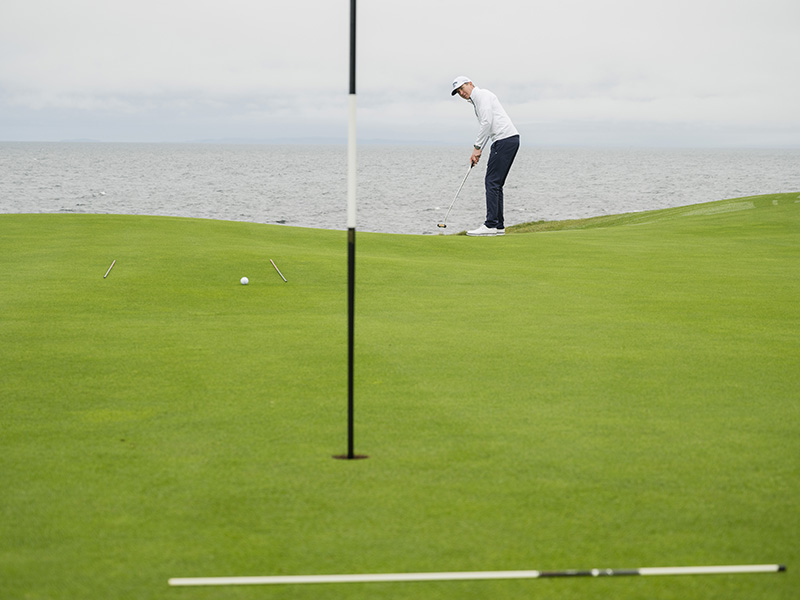How To Read Greens: 4 Expert Drills From Top PGA Professionals
Learning how to read greens on a golf course is one of the most important skills an amateur golfer can learn. These 4 drills can show you how to putt like a pro


I recently spent a day learning how to read greens with a top tour putting coach, and it was the best investment I have made in my pursuit of progress on the golf course.
One of the best putting tips that I received on the day was around the relationship between reading the green and distance control when putting, as without the ability to marry the two together your efforts will ultimately be futile.
I like to spend time the night before a round practicing my stroke, as it helps me to feel more confident over the ball the following day. With the best putting mats on the market, you now have the chance to practice your pace control and ability to read the break when putting from the comfort of your own home - and the best putting training aids can also set you up for success on the practice green at your club.
In the video and article below, Golf Monthly Top 50 Coaches Alex Elliott and Ben Emerson share some expert green reading tips and drills that will help you develop your understanding of how to read greens in golf...
What is green reading?
What does 'green reading' mean in golf?
Green reading is the skill of anticipating how your ball will move on its journey from the putter face to the hole. The movement of the ball will depend on the severity of the slopes and the speed of the greens, so players should factor this in when aiming and creating the start line for their putt.
If players putt without attempting to read the green, they will likely miss slopes that could take the ball further away from the hole. This can be particularly troublesome if the putt is missed on the low-side, as the ball could travel some distance and leave a tricky returning putt.
Subscribe to the Golf Monthly newsletter to stay up to date with all the latest tour news, equipment news, reviews, head-to-heads and buyer’s guides from our team of experienced experts.
What are the most common methods of green reading?
Many top professionals on the PGA Tour, DP World Tour and LIV Golf use AimPoint to read putts on the green, which is a system that uses your feet to assess the slopes on the green. Other top players simply read the green by eye or use their experience of particular courses to memorise slopes and break habits.
There are other methods used on tour that you could learn, including how to plumb bob a putt, and amateurs are advised to try each to discover which is best suited to them.
How To Read Greens On A Golf Course
Alex Elliott's Green Reading Drill

Alex spent three years caddying on the European Tour before taking his PGA qualifications. Since then he has created a thriving social media platform on Instagram and YouTube, where he offers a whole host of tips and advice to help viewers shoot lower scores.
1. The Coin Drill
Reading a putt is one of the hardest skills in golf to master, and I often get asked for my best putting drills for this key area when coaching amateur golfers. I find that keeping it simple is the most effective way to drive improvement, so I devised a straightforward method that can help players of all abilities.
For a right-hander, left-to-right putts tend to prove really difficult. I know they strike fear into me sometimes. I used to find it really hard to start the ball where I wanted to, and even when I did, I'd have misread the break.
If this sounds like something that happens to you, take two coins with you next time you're going to practice putting green. Look at a putt from all angles until you feel like you've got a good idea of the line and then plot the journey using the two coins.

Plotting intermediate targets will help you read putts much better
This gives you two intermediate points that the ball needs to track over in order to find the bottom of the cup and provides a great way of visualising how a putt breaks. Don't worry if you don't get it right first time. The idea is you learn from what you did and build this visualisation into your pre-shot routine.
If you can team this with a good pace putting drill, you should be able to avoid 3-putting and maybe even hole the odd tram-liner!
For me, this is the best way to read greens as it builds a strong picture of a putt when you're out on the course and will therefore improve your chances of starting the ball where you want to. All you've got to do then is match the pace and you're onto a winner.
Ben Emerson's Green Reading Drills

Ben Emerson is a Golf Monthly Top 50 Coach with a modern approach to the game. His methods have seen him become one of the most revered coaches in the country, and even has a few celebrity clients on his books. In his coaching career of more than 20 years, Ben has helped golfers of all ages and abilities to improve their performances and enjoy the game.
2. The 'Advanced' Ladder Drill
The word 'advanced' in the title of this drill doesn't mean it's not suitable for beginners, in fact golfers of all abilities should be trying this out on the practice green. The advanced element comes from adding slope into our drills, as you will rarely have a flat putt on the course.
A standard ladder drills requires you to putt into different zones on the ladder from a fixed starting point, working on your distance control. The purpose of adding slope is to marry your distance control with green reading ability, which is the recipe for better putting.
Set up a ladder using tees, as demonstrated in the image below. We used the alignment sticks to show visually how the ladder breaks with the slope, but these aren't essential for you to add into your practice.
Start with three balls and set up with your normal putter grip. Aim to stop one ball in each of the three zones of the ladder. If you miss a zone, you have to start again. Remember, the length of the putting backswing vs the follow through should be identical to ensure consistent results.
Try this out with different distances and slopes on the green, and you will notice your green reading and pace control improving on the course.

This ladder drill is advanced due to the sloping nature of the putts, but players of all abilities should be trying this in their practice
3. The Gate Drill
For this drill, I want you to completely take the hole out of your mind and focus instead on the start line. So many amateurs will aim straight at the hole every time and then wonder why they are missing the putt by six feet or more. If we can read the high point of the putt correctly, and identify the start line, a challenging putt will become a lot easier.
Identifying the high point of the putt is essentially understanding where the putt will reach it's highest point and start to break most. You can do this with your feet by walking along the line with your feet straddled and feeling where the slope is most severe.
Set up a gate around three foot from your ball, measured at around one putter head's width, which is aiming directly at that high point. This is a great putting drill using tees - something every golfer has in their bag.
In the image below, I have used white markers to visualise the break of the putt. If you don't have access to these, you could use a tee or a ball marker to highlight the high point of the putt.
The aim is to practice hitting the start line effectively, allowing the ball to travel on your intended line and complete it's journey by cosying up to the hole (or going in - of course).
Pick different breaking putts, with varying severity, and you will be able to master slopes in no time at all.

Focus on your start line, as well as the high point, to ensure the ball has the best chance of reaching your target
4. Alignment Stick Drill
Every golfer should spend time working out whether they prefer to hit short putts firm or dead-weight, experimenting with different slopes, but for many amateurs their average proximity to the hole will be far greater. This drill focuses on marrying line with pace from a longer distance, and requires three alignment sticks or a handful of tees.
Set up a gate along the slope you have selected, ensuring it incorporates the high point of the putt that I mentioned above.
Take six balls and aim to putt the ball through the alignment stick gate (or zone) as it wanders down towards the hole. The key here, however, is to ensure that the ball doesn't go past the alignment stick barrier placed two feet behind the hole.
This will allow you to focus on correctly reading the line, while also preventing that annoying error where the ball races another 10 foot past the hole - leaving another challenging putt.
Set up your own scoring system and see if you can beat your personal best. I would suggest saying one point if the ball passes through the gate, another point if it stops past the hole but before the stick and two points if it goes in.
Add some jeopardy by taking points away for putts that stop short of the hole, or those that race over the barrier. This will help to make your practice fun and will drastically improve your performances with the flat stick when you are next on the course.

This putting drill can be made into a competitive game which adds pressure to your practice
Can I Practice Putting On The Golf Course?
So, you are heading out for 18-holes and want to know if you can practice putting on the course. Well, the answer to this depends on the situation. If you are due to play a stroke play competition, you are not allowed to practice on the course before your round but you can hit a couple of putts after completing each hole. So, if you have missed a three-footer and want another go to shake off that bad feeling, go ahead!
If you are playing a match play competition, you are allowed to practice on the course before or between rounds. It goes without saying that plenty of members will also choose to have a few practice putts when playing in a casual round alone or with friends, but be sure to check your club's policy on this.

Baz joined Golf Monthly in January 2024, and now leads the instruction section across all platforms - including print and digital. Working closely with Golf Monthly's Top 50 Coaches, he aims to curate and share useful tips on every aspect of the game - helping amateurs of all abilities to play better golf. Baz also contributes weekly to the features section, sharing his thoughts on the game we love and the topics that matter most. A member at Sand Moor Golf Club in Leeds, he looks forward to getting out on the course at least once a week in the pursuit of a respectable handicap.
Baz is currently playing:
Driver: Benross Delta XT
3-Wood: Benross Delta XT
Hybrid: TaylorMade Stealth 4 Hybrid
Irons: Benross Delta XT 5-PW
Wedges: TaylorMade RAC 60, Callaway Jaws MD5 54
Putter: TaylorMade Spider Tour
- Alex ElliottTop 50 Coach
- Ben EmersonTop 50 Coach
You must confirm your public display name before commenting
Please logout and then login again, you will then be prompted to enter your display name.